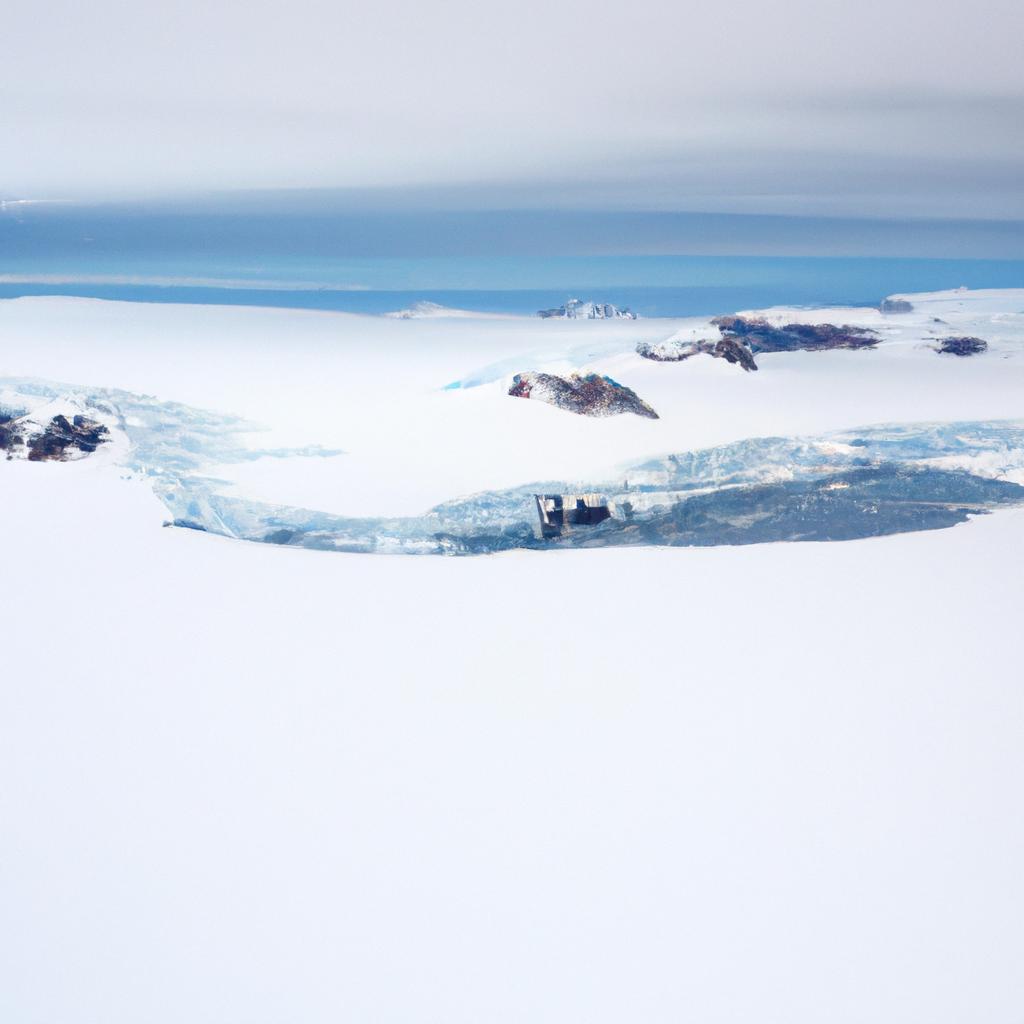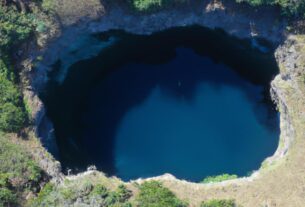Taylor Glacier in Antarctica is a massive icy behemoth known for two extraordinary features: the Blood Falls and Subglacial Lake Mercer. These remarkable phenomena have captured the attention of scientists worldwide, who are eager to unravel the secrets hidden beneath the glacier’s surface.
Location and Characteristics of Taylor Glacier
Located in the McMurdo Dry Valleys of East Antarctica, Taylor Glacier reigns as the largest glacier in the region. Stretching approximately 54 kilometers long and 19 kilometers wide, it blankets an area of roughly 1,500 square kilometers. The ice’s distinctive blue hue results from the way it absorbs and scatters light.
Taylor Glacier is particularly famous for the blood-red waterfall known as the Blood Falls. This cascading marvel flows from a rift in the glacier, fueled by an iron-rich subglacial lake. The waterfall’s unusual color has captivated scientists for decades, and research has shown that the water in the lake is around 2 million years old.
Furthermore, the glacier is home to Subglacial Lake Mercer, discovered in 2007. This hidden body of water, one of several subglacial lakes in the area, has remained isolated from the outside world for thousands of years, making it a subject of great interest to the scientific community.
Unveiling the Secrets of the Blood Falls
The Blood Falls on Taylor Glacier is an enthralling feature that owes its name to the iron-rich water that gives it a blood-red hue. This water originates from a subglacial lake concealed beneath the glacier’s icy surface.
Scientists estimate that this ancient lake has been isolated from the outside world for a staggering 2 million years. Notably, the water’s high salt content allows it to flow freely beneath the glacier. Upon exposure to oxygen at the surface, the iron oxidizes, transforming the water into a captivating crimson spectacle. These falls have fascinated scientists for decades, and ongoing research aims to unlock the mysteries of the subglacial lake.
Taylor Glacier is of immense importance to scientists and researchers worldwide. Its unique characteristics offer a trove of information about our planet’s history and evolution.
Investigating Climate Change on Taylor Glacier
Climate change research is a primary focus when it comes to Taylor Glacier. Significantly, this glacier is one of Antarctica’s fastest-melting glaciers, providing an excellent opportunity to study the repercussions of climate change on the region.
Scientists employ various techniques, including remote sensing, ice-penetrating radar, and on-site observations, to investigate the glacier’s dynamics. Through these studies, scientists aim to gain a comprehensive understanding of how climate change impacts the region and identify measures to slow down the melting process.
Unraveling the Planet’s Evolution
Taylor Glacier is an invaluable asset for scientists exploring the Earth’s evolution. The Blood Falls and Subglacial Lake Mercer offer a unique window into the region’s history, concealing untold secrets beneath the glacier’s surface.
Research on the glacier has already revealed a wealth of information, including evidence of past volcanic activities and climate fluctuations. By continuing to study Taylor Glacier, scientists hope to unravel how our planet has evolved over time and gain insights into its future.
The Enigma of the Blood Falls
The Blood Falls, a distinctive feature of Taylor Glacier, have captivated scientists and researchers globally. These falls derive their name from their distinct blood-red color, attributed to the iron-rich water flowing from a subglacial lake located beneath the glacier.
Notably, the Blood Falls provide an exceptional opportunity for scientific research on the subglacial lake and its water. Scientists employ an array of techniques, including remote sensing, on-site observations, and chemical analysis, to study this fascinating phenomenon.
Research on the Blood Falls has uncovered a treasure trove of information, including evidence of microbial life. Despite the extreme conditions beneath the glacier, the water’s high salt content makes it hospitable to life forms, further deepening the mystery. By analyzing the water in the falls, scientists strive to gain a better understanding of the history and development of the lake and the wider region.
Subglacial Lake Mercer
Subglacial Lake Mercer, discovered beneath Taylor Glacier in 2007, is another captivating feature of this Antarctic wonder. Scientists are particularly interested in this isolated subglacial lake, which has been cut off from the external world for thousands of years.
Research on Subglacial Lake Mercer has yielded valuable insights into the region’s biology and geology. Scientists have discovered evidence of microbial life, including bacteria and archaea, within the lake. Moreover, the lake’s sediments offer crucial clues about the region’s climate history, aiding in understanding past changes and predicting the future.
Additionally, Subglacial Lake Mercer intrigues researchers investigating the potential for life on other planets. Its extreme conditions resemble those found on extraterrestrial bodies, suggesting that the lake might hold critical information about life’s viability elsewhere.
In summary, Subglacial Lake Mercer is a captivating aspect of Taylor Glacier that has seized the attention of scientists worldwide. Its distinct properties, combined with isolation from the external world, make it an ideal subject for scientific exploration, offering invaluable insights into our planet’s history and evolution.
Unveiling Taylor Glacier’s Secrets through Research Studies
Over the years, Taylor Glacier has been the object of numerous research studies that have provided invaluable insights into the region’s history, evolution, and the impacts of climate change on the glacier.
Overview of Past and Current Research Studies
While research on Taylor Glacier dates back to the early 20th century, it was not until the 1990s that scientists began delving into its unique features, such as the Blood Falls and Subglacial Lake Mercer. Since then, a multitude of studies have been conducted, covering various areas of interest.
Climate change is a prominent focal point in research on the glacier. Researchers utilize remote sensing, ice-penetrating radar, and on-site observations to study the glacier’s dynamics. These studies have revealed alarming rates of glacier melt, posing significant implications for the region and the planet at large.
The Blood Falls represent another crucial area of investigation. Scientists have dedicated decades to deciphering the secrets of the subglacial lake responsible for these falls. Recent studies have shed light on the lake’s age, estimated at 2 million years, and its complete isolation throughout that time.
Findings and Implications of the Studies
The studies on Taylor Glacier have furnished a wealth of information about the region’s history, evolution, and the impacts of climate change on the glacier. Key findings include:
- The glacier is melting at an alarming rate, signifying substantial implications for the region and the planet.
- The Blood Falls result from an iron-rich subglacial lake, isolated for millions of years.
- Subglacial Lake Mercer’s water is exceptionally salty and has remained isolated for thousands of years.
These findings hold significant implications, offering invaluable insights into the region’s history, evolution, and the planet’s response to climate change. Additionally, they emphasize the necessity for further research to unveil the secrets concealed beneath the glacier’s surface.
Future Research Directions
The mysteries of Taylor Glacier are far from solved, prompting the need for ongoing research. Future investigations will explore a range of topics, including:
- The impacts of climate change on the glacier and the region.
- The history and evolution of the subglacial lake feeding the Blood Falls.
- Biological and geological discoveries within Subglacial Lake Mercer.
With continued research, scientists aspire to deepen our understanding of the region and the planet’s future.
Conclusion
In conclusion, Taylor Glacier stands as an exceptionally captivating region in Antarctica, offering profound insights into our planet’s history and evolution. From the awe-inspiring Blood Falls to the enigmatic Subglacial Lake Mercer, the glacier’s unique features have captivated scientists and researchers worldwide.
Research on Taylor Glacier has already yielded valuable insights into the impacts of climate change on the region and the planet’s history and evolution. Nonetheless, much remains to be uncovered, necessitating further research to reveal the secrets concealed beneath the glacier’s surface.
As we continue our exploration of Taylor Glacier, we gain a deeper comprehension of our planet and the measures required to safeguard it for future generations. Let’s forge ahead in our quest to unravel the mysteries of this extraordinary region in Antarctica. You can learn more about TooLacks on our website here.



